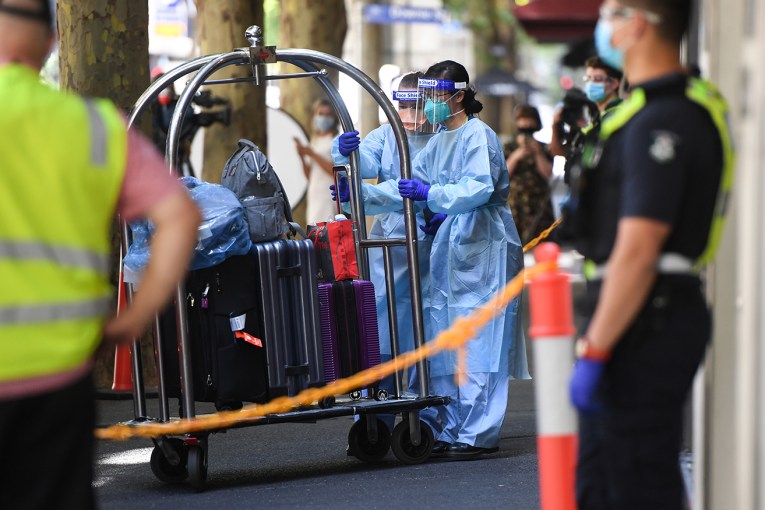From mRNA to mixing COVID-19 jabs: Here’s what you need to know about the Moderna vaccine


Everything you need to know about the Moderna vaccine. Photo: TND
The Morrison government this week announced it has secured 25 million doses of Moderna’s COVID-19 vaccine in an effort to get Australia’s vaccine rollout back on track.
The vaccine is yet to approved by the Therapeutic Goods Administration and there is no clear timeline for when it is arriving, so it might not be time to pop the champagne corks yet.
In the meantime, though, here is everything you need to know about how the Moderna vaccine works and its safety and efficacy.
How it works
The Moderna vaccine is very similar to that of Pfizer.
Both vaccines require two doses and are made using a new technology, called messenger RNA (mRNA) to unlock the body’s immune defences.
“It’s an mRNA vaccine, so it introduces the instructions for the spike proteins,” explained Associate Professor Paul Griffin, who leads the University of Queensland’s infectious disease unit.
“In terms of success rate, they are very similar and very safe.”
The mRNA teaches our cells to make a harmless piece of the SARS-CoV-2’s “spike protein” that is found on the outside of the coronavirus.
According to the United States’ Centres for Disease Control, the (mRNA) gives “instructions for the body to make the cells and, after the protein piece is made, the cell breaks down the instructions and gets rid of them”.
Once the body can make the protein, it can recognise it and fight it off.
“Immune systems recognise that the protein doesn’t belong there and begin building an immune response and making antibodies, like what happens in natural infection against COVID-19,” the CDC said.
So if someone who has been immunised comes into contact with COVID-19, they are less likely to get seriously ill.
Is it safe?
The Moderna vaccine protects 94 per cent of people and has a 100 per cent success rate of fighting off severe COVID-19 cases.
Dr Griffin said the Moderna vaccine “is highly efficacious, with very few safety problems”.
“We’ve seen a few allergies, but this gives us the excellent capacity to ensure ongoing supply,” he said.
Clinical trials involving 30,000 people have shown Moderna to be safe and effective.
Some people have experienced side effects, including fatigue, headache and muscle soreness after the first and second dose.
Another bonus is the Moderna vaccine is slightly easier to store than Pfizer – it needs to be kept at minus 20 degrees, rather than minus 70, and can be used for up to six months after opening each vial.
The doses can also be kept at room temperature for 12 hours, meaning healthcare workers will not have to pull it in and out of the fridge each time they use it.
The vaccine is currently being used in nations including the UK and the US, with each of their regulators declaring it safe.
But to get it into the upper arms of Australians, Moderna has to win the approval of the TGA.
This will likely take about three months after the initial submission is made.
Moderna has flagged it will be applying for approval immediately.
The more vaccines the better
Pfizer and AstraZeneca vaccines are currently being rolled out, and Australia also has a deal in place for about 51 million doses of Novavax, which is still in the trial phase.
Although the Moderna announcement is good news, it shouldn’t “distract from how important the other vaccines will be”, Dr Griffin said.
“In and of itself, Moderna is not the only vaccine we need. We’ll need a range of them,” he said.
“But as an additional vaccine to hopefully address some issues of supply, this is definitely a good step forward.”
The booster shot
The Australian government’s agreement with Moderna also includes 10 million booster shots that are designed to protect against two variants of concern: B.1.351 (South Africa) and P.1 (Brazil).
Senior lecturer at the Australian Catholic University and specialist adviser to the TGA, Roger Lord, said approval of the booster would be good news as Australia would be better protected.
“The additional features of mRNA-1273 may, however, have an undesired effect of further stalling Australia’s current COVID-19 vaccine rollout with the appearance of better protection compared to vaccines currently on offer,” Dr Lord added.
“Australians may become confused as to whether it is better to wait for a more effective vaccine, or accept what is being offered now.”
Mixing shots
If it was drinks, you wouldn’t want to do it.
But with the vaccines, it will be OK to “mix and match” with the booster shot you get, according to federal health secretary Brendan Murphy.
“[Moderna is] our foundation of a booster and variant strategy,” Professor Murphy told reporters.
“Moderna is, on the advice that we have, the most advanced of the vaccine products with relation to the capacity to adapt to booster and various requirements.”
There could also be “some benefit” to getting vaccines of different types, but further studies are still under way, he said.
“There is no good scientific reason why you can’t boost with one and then have another vaccine later,” Professor Murphy said.








